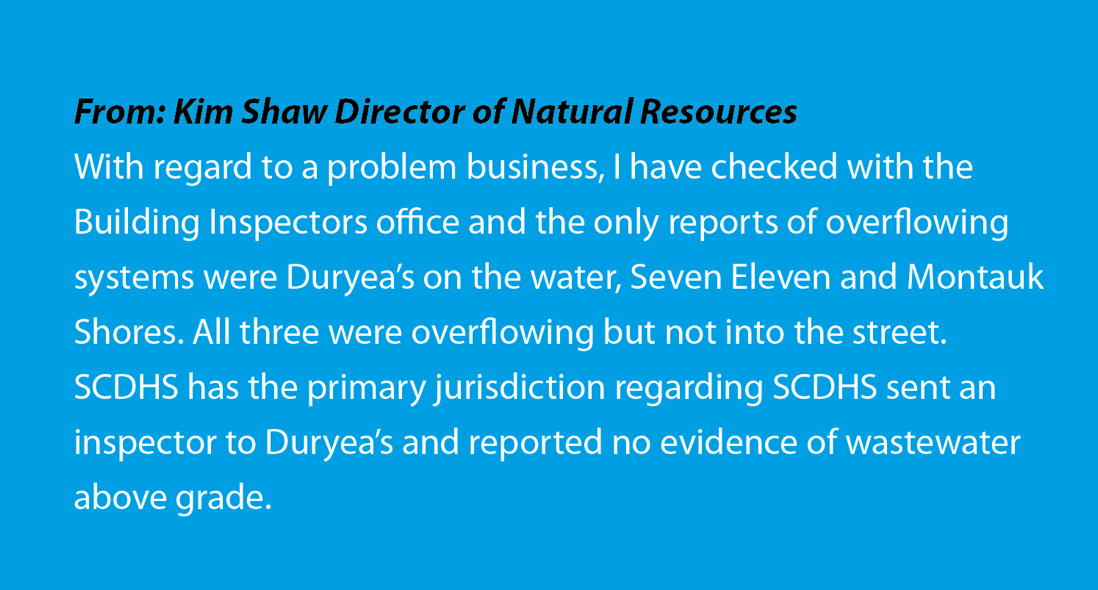
FAQ’s
What’s this about Montauk’s “Raw Sewage” problem?
There is no problem with “raw sewage” in Montauk. This is a loaded term which the Town Supervisor has been using, apparently in order to frighten people into thinking that the groundwater in certain parts of Montauk poses a threat to human health. It does not.
The Town Supervisor has stated that 529,697 gallons of “raw sewage” are being dumped into Montauk’s environment every day. This is untrue.
Sewage water consists of household sink water, human waste, food scraps, commercial or industrial wastewater, and the like. It contains harmful microorganisms, such as bacteria, viruses and parasites.
All sewage emanating from commercial, residential, and institutional properties on Montauk is discharged into underground septic systems or similar systems for the treatment and disposal of wastewater. Some places, such as the Montauk Manor and the Rough Riders Condominium, have their own private sewage treatment plants. Some homes and businesses have in recent years installed Innovative & Alternative On-site Wastewater Systems (I/A OWTS), which remove most of the nitrogen produced by septic waste.
If a septic tank were to exceed its capacity the egress hatch would be forced open and sewage would leak out. Such a condition is illegal and would violate County and State health codes. Businesses (and residences) are required to ensure that sewage is contained within their septic systems so leakage does not occur. Once a septic tank begins to reach capacity, the sewage is pumped out into a septic waste removal truck and is transported to a licensed sewage treatment plant up-Island.
NONE of the sewage generated by any of Montauk’s businesses, residences, condominiums, or institutional uses (schools, library, and government or parks facilities) is simply discharged in the open. THAT would be “raw sewage,” and s just noted such discharge would be illegal.
Some Montauk business establishments, including certain hotels and restaurants, have inadequately-sized septic systems or problems with a high groundwater table. These businesses may need to pump out their septic systems frequently, especially during the summer months. But they don’t discharge “raw sewage” into the streets or into bodies of water. If they did that, they would be prosecuted and possibly forced to cease operating.
In short, there is no “raw sewage” in Montauk’s streets or in its surface waters.
Does Montauk waste water have elevated levels of Nitrogen?
YES. In certain areas of Montauk, including the Downtown Business District, relatively high levels of development and old or inadequately sized septic systems have led to elevated levels of nitrogen in groundwater – particularly during the summer months.
While high nitrogen levels are not desirable, and attempts should be made to alleviate this problem, the situation is not so critical as proponents of a Montauk Sewer District seem to maintain. In Downtown Montauk, for example, groundwater is not used for drinking or irrigation purposes. As far as is publicly known, there are no private wells in the Downtown area and certainly no public wells.
Almost all of the groundwater beneath Downtown Montauk slowly moves south and seeps into the Atlantic ocean. Although this groundwater is rich in nutrients (phosphorus, as well as nitrogen), there is no evidence that it is harming water quality along Montauk’s ocean beaches. The volume of nutrients carried into the sea by groundwater is minuscule in comparison to the volume of the ocean itself.
A more serious concern would be the impact of nutrient-rich groundwater on Fort Pond. High levels of nitrogen in Fort Pond could lead to algal blooms, hypoxic water conditions, and possibly fish kills. However, an examination done by the Town’s consulting engineers shows that only a very small proportion of the groundwater beneath Downtown Montauk actually flows into Fort Pond. In a 2021 scientific analysis by H2M, it was determined that putting sewers throughout Downtown Montauk would reduce nitrogen inputs into Fort
H2M Report- Rev 2, Sec 2.3.1, page 3: Nitrogen budget reduction of 2% in Fort Pond
Pond by as little as two per cent (2%). By far the predominant source of nitrogen entering Fort Pond is the septic systems which serve homes, businesses, and institutions located either east or west of Fort Pond (for example, in Shepherd’s Neck). Thus, a sewer system in Downtown Montauk would provide only minimal environmental benefit to Fort Pond, and at a high economic cost.
In other areas of Montauk, such as the south end of Lake Montauk, high levels of nitrogen and phosphorus do flow into the lake from the densely developed Ditch Plains area (400 homes), especially in the summertime. This is harmful to the health of Lake Montauk, especially its southern end, and sometimes leads to shellfish closures, or warnings against swimming off the public beach at South Lake Drive.


© 2023 Whalenworks LLC
Design by Whalenworks, all rights reserved
© 2023 R.E. Whalen, photos used by permission
All photos ©copyright R.E. Whalen, used by permission